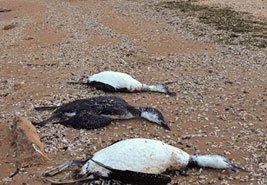But, for better and for worse, based upon an array of environmental and climatological conditions, one can set their clock by when the die offs take place. The next step, biologists say, is finding preventative measures to deal with those conditions to preserve a species already threatened in the state. The problem is, at this point, solutions are hard to come by. Unfortunately, the loons, a symbol of northern lakes and wild places with their eerily lonely two-note call, serve as the end result sentinel of a growing environmental danger in the Great Lakes.
According to the United States Geological Survey (USGS), there are about 30,000 common loons in the United States. During the breeding season, from early spring to late fall, about half of them reside in the Great Lakes’ states of Michigan, Wisconsin and Minnesota.
In 2012, thousands of dead birds, mainly common loons washed up dead on Lake Michigan shorelines – from the Upper Peninsula, down to the Sleeping Bear Dunes National Lakeshore. A large percentage of the dead loons had just entered their first year of breeding maturity. While the mortality rate in 2012 was the worst on recent record, it followed similar incidents that took place in 2006, 2007 and 2010.
The Macomb Daily
15 Nov 2013
D Gardner









